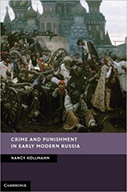Crime and Punishment in Early Modern Russia

Author: Nancy Shields Kollmann
Publisher: Cambridge, UK, New York: Cambridge University Press, 2012. 503p.
Reviewer: Jeffrey S. Hardy | January 2014
Nancy Kollmann, one of the preeminent scholars of early modern Russia, has written the definitive account of how justice was conceived of, organized, negotiated, and ultimately administered in Russia from the 1500s to the early 1700s. Crime and Punishment in Early Modern Russia offers a painstakingly detailed and nuanced picture of Russia’s criminal justice establishment, from recruiting and training officials to the use of torture and exile, from criminal procedure in police work and in the courts, to the punishment of witches, heretics, and rioters.
The thematically-organized chapters of Crime and Punishment are dense, yet readable. They feature many pages of description and analysis of the myriad institutions engaged in administering justice in the cities, towns, and provinces of Russia. Fortunately for the reader, these sections are interspersed with equally lengthy and illuminating narratives of how Russians on a very personal level experienced justice. These intimate stories, drawn primarily from legal institutions in and around the towns of Beloozero and Arzamas, do well to enliven what otherwise might be a dry, technical text. More importantly, they serve the purpose of illustrating one of Kollmann’s main arguments: the justice system in Russia, despite the protests of contemporary foreign observers and nineteenth-century Russian historians, actually worked pretty well. More often than not, guilty parties were punished, offended parties were compensated, and state power was upheld. Kollmann also argues against conventional wisdom by asserting that the Russian legal establishment was not rife with corruption. A gift-giving economy certainly existed, but this was not unique to Russia. And in fact, a few factors mitigated against widespread corruption. First, the tsar’s legitimacy was constructed in part on his ability to adjudicate fairly in legal matters. Second, the necessary buy-in from local communities resulted in a negotiated system that favored neither central officials nor local actors and kept checks on both.
Beyond the meticulous and intimate descriptions of how justice worked in Russia, the greatest strength of this book is its attention to locating Russia within the early modern framework. Comparisons with Western and Central Europe and the Ottoman Empire abound. And Kollmann persuasively argues that Russia fit neatly within this paradigm in that it was a centralizing state that relied on a legitimizing religious ideology and that it adopted “flexible strategies of governance” in the legal sphere. There were certainly differences between Russia and Europe, but ultimately not substantive ones. Russia had no lawyer class, but various officials and informal advisers effectively filled this gap. Russia also lacked established interest groups that forced judicial flexibility in Europe; its skeletal state apparatus in the sparsely-populated countryside, however, forced local cooperation and a similar level of flexibility to Europe. Another central point of the comparative approach is that “Russia was not a despotism,” at least not any more so than its contemporary states (426). Its justice system was governed largely by procedure and tradition, and it does not appear to have been more violent than Europe. In fact, Russia began moving away from capital punishment—already in the late seventeenth century—earlier than the rest of Europe. Nor did it glorify violence with “spectacles of suffering,” until Peter I began introducing such rituals based on European influences.
Crime and Punishment in Early Modern Russia is without doubt the best recent book on the administration of justice in pre-1917 Russia, and it seems unlikely that it will be superseded anytime soon. Indeed, it sets a new standard for how this topic should be approached and researched. Engaging in the important theoretical and historiographical debates surrounding the sociology of punishment (Foucault, Elias, Spierenburg, etc.) and the formation of early modern statehood, it is also compelling reading for a much broader community of scholars.
Jeffrey S. Hardy, Assistant Professor of History, Brigham Young University


